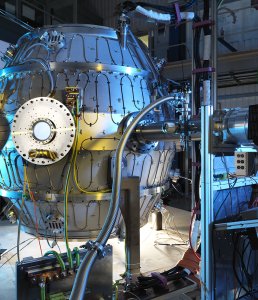Dynamics and Stability of a Thin Liquid Lithium Flow within a Tokamak Divertor

- Researcher: Davin Lunz
- Academic Supervisor: Peter Howell
- Industrial Supervisor: Peter Buxton
Background
The world’s increasing population is in great need of energy sources not coming from fossil fuels, due to, among other reasons, diminishing fossil fuel supplies and their effect on the environment. Nuclear fission could be curtailed by issues of public and political acceptability due to the enriched fuel required and the waste products. Renewables, including solar, wind, and hydro, are reliant on environmental conditions and often require vast, vacant areas of land or sea (see Mackay's 2009 book Sustainable Energy: Without the Hot Air). Renewables must play a key role in future energy grids, however nuclear fusion has the potential to solve many of the present issues and constraints.
 Nuclear reactions release about one million times more energy per mass of fuel than a chemical reaction such as the burning of coal, oil or gas. Fusion offers a long-term source of energy, with zero carbon emissions and no long-lived radioactive waste (the fusion reaction itself produces no waste directly, and while the high-energy neutrons that are released make the vessel radioactive, suitable choice of materials should give the irradiated components short half-lives). The fusion process is inherently much safer than fission since it is thermally self-limiting, so no chain reaction can occur, and no reactor meltdown or far-reaching disaster is possible. There is an almost unlimited supply of fuel, with no need for enriched material.
Nuclear reactions release about one million times more energy per mass of fuel than a chemical reaction such as the burning of coal, oil or gas. Fusion offers a long-term source of energy, with zero carbon emissions and no long-lived radioactive waste (the fusion reaction itself produces no waste directly, and while the high-energy neutrons that are released make the vessel radioactive, suitable choice of materials should give the irradiated components short half-lives). The fusion process is inherently much safer than fission since it is thermally self-limiting, so no chain reaction can occur, and no reactor meltdown or far-reaching disaster is possible. There is an almost unlimited supply of fuel, with no need for enriched material.
In order to accomplish the fusion reaction the atoms need to be very hot (around ten times hotter than the core of the sun) and very dense. To this end, the fusion fuel is magnetically confined in a toroidal chamber (called a tokamak, like Tokamak Energy’s ST-40 pictured above) so that it is physically isolated from the walls and can remain hot enough. However, some heat and particles will escape the confinement and are carefully directed to a component known as the divertor. The divertor must be able to withstand very high heat loads, which cause solid materials to sustain significant damage over time. Flowing liquid metal is one of the most promising materials for the divertor because of its ability to recover after disruptive events, so no surface damage occurs.
The goal of this project is to use mathematical modelling to understand the behaviour of liquid divertors in order to improve their design and control.
Outcomes
My project, in collaboration with Tokamak Energy, aims to model the flow of a liquid metal in the presence of a strong applied magnetic field using Magnetohydrodynamics (MHD; a coupling of Maxwell’s equations of electromagnetism with the Navier-Stokes equations of fluid dynamics) to ascertain how the liquid divertor will behave in various conditions and when instabilities might occur, to help best design and control the divertor in operation. Our models suggest that the presence of the magnetic field results in interesting flow profiles but that, under reasonable conditions, these are stable to various perturbations [1]. However, in some practical regimes in which tokamaks operate, interaction with the core plasma may excite resonant deflections of the free surface [2]. Future work might consider more complicated geometries of the applied field and divertor substrate.
Publications
[1] Flow of a thin liquid-metal film in a toroidal magnetic field, D. Lunz, P. D. Howell. J. Fluid Mech. (2019), vol. 867, pp. 835–876.
[2] Dynamics of a thin film driven by a moving pressure source, D. Lunz, P. D. Howell. Phys. Rev. Fluids 3, 114801 (2018)

